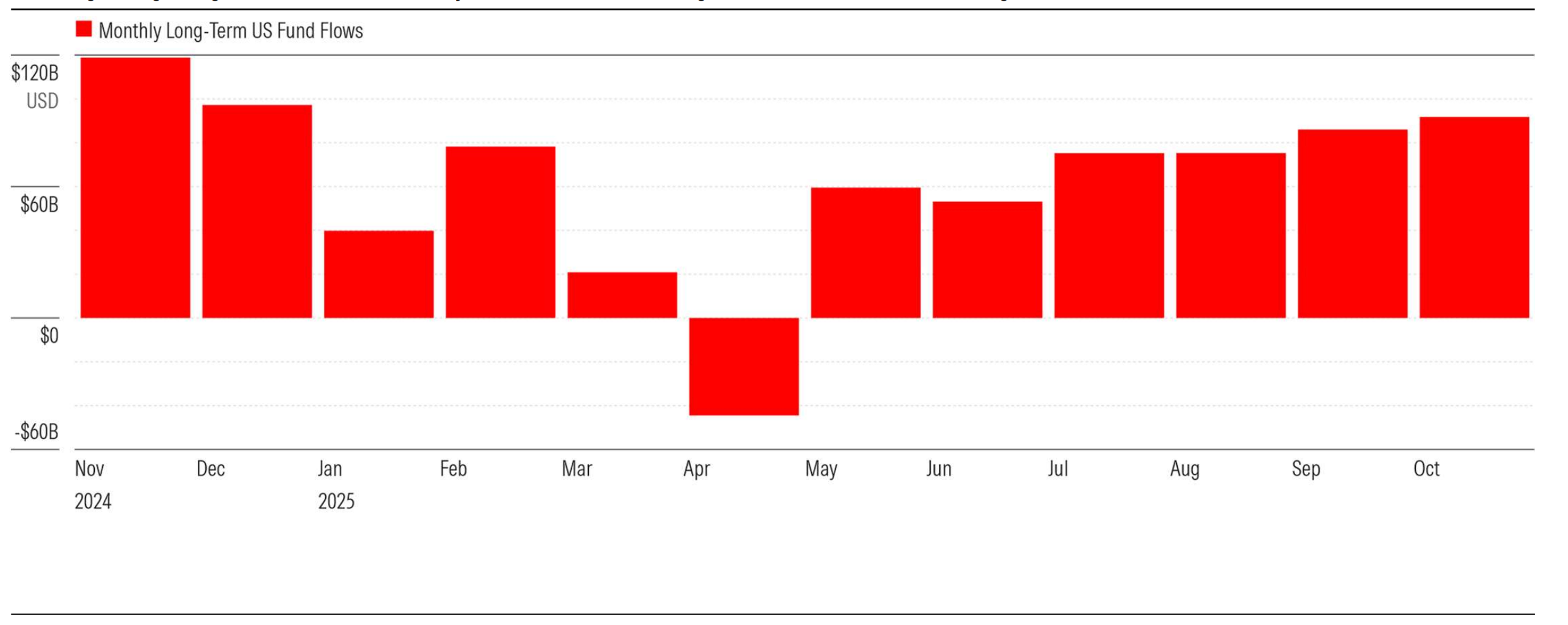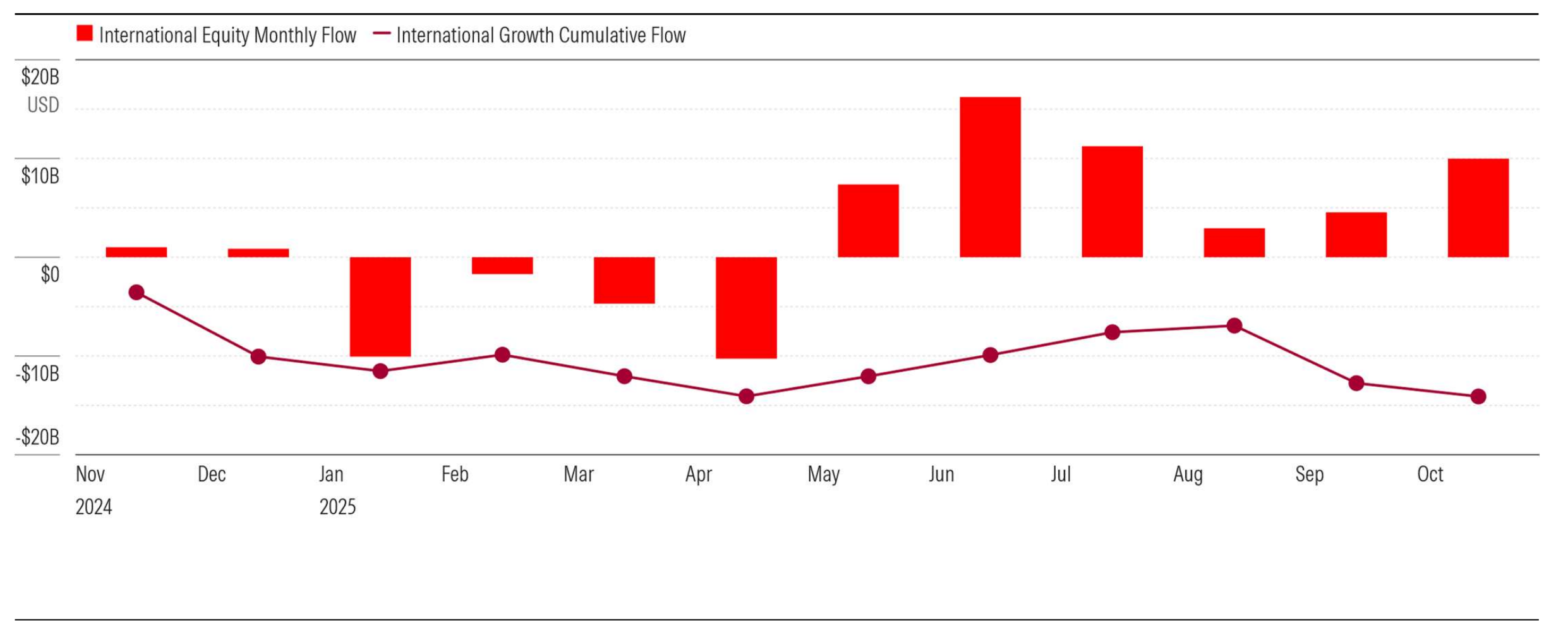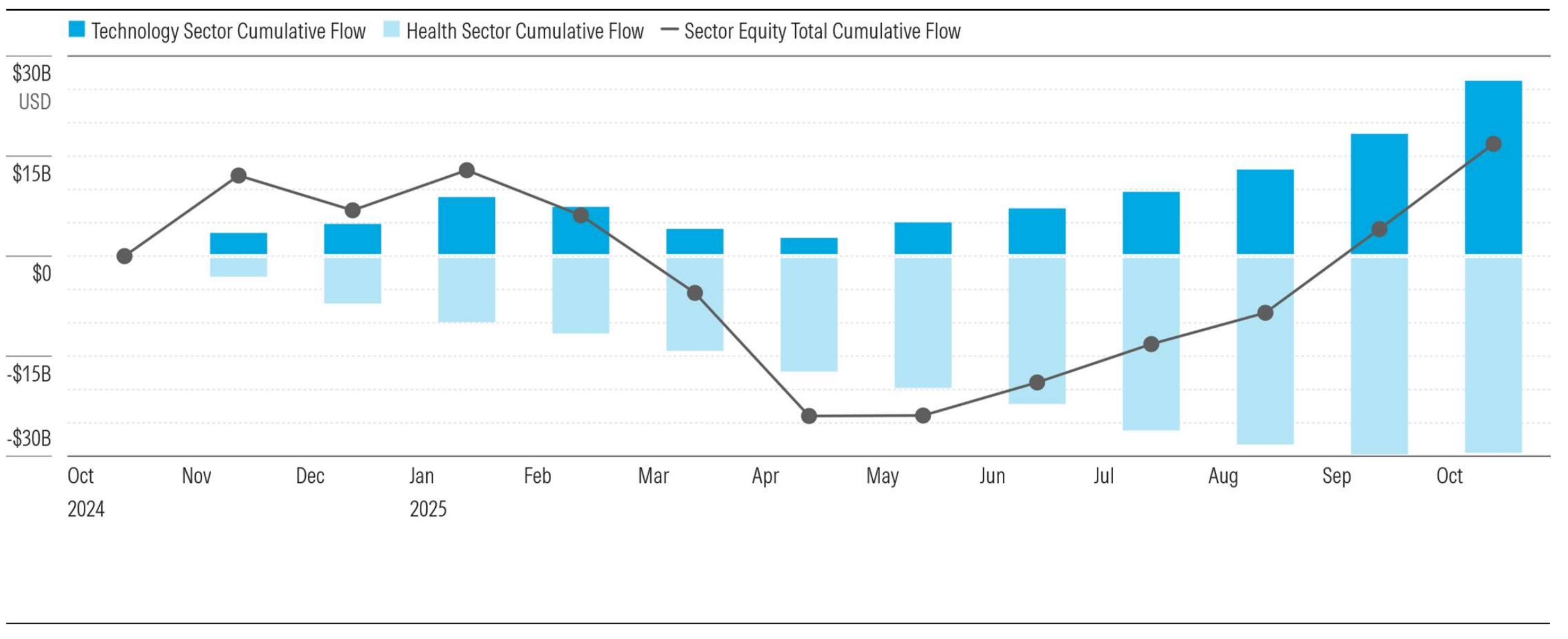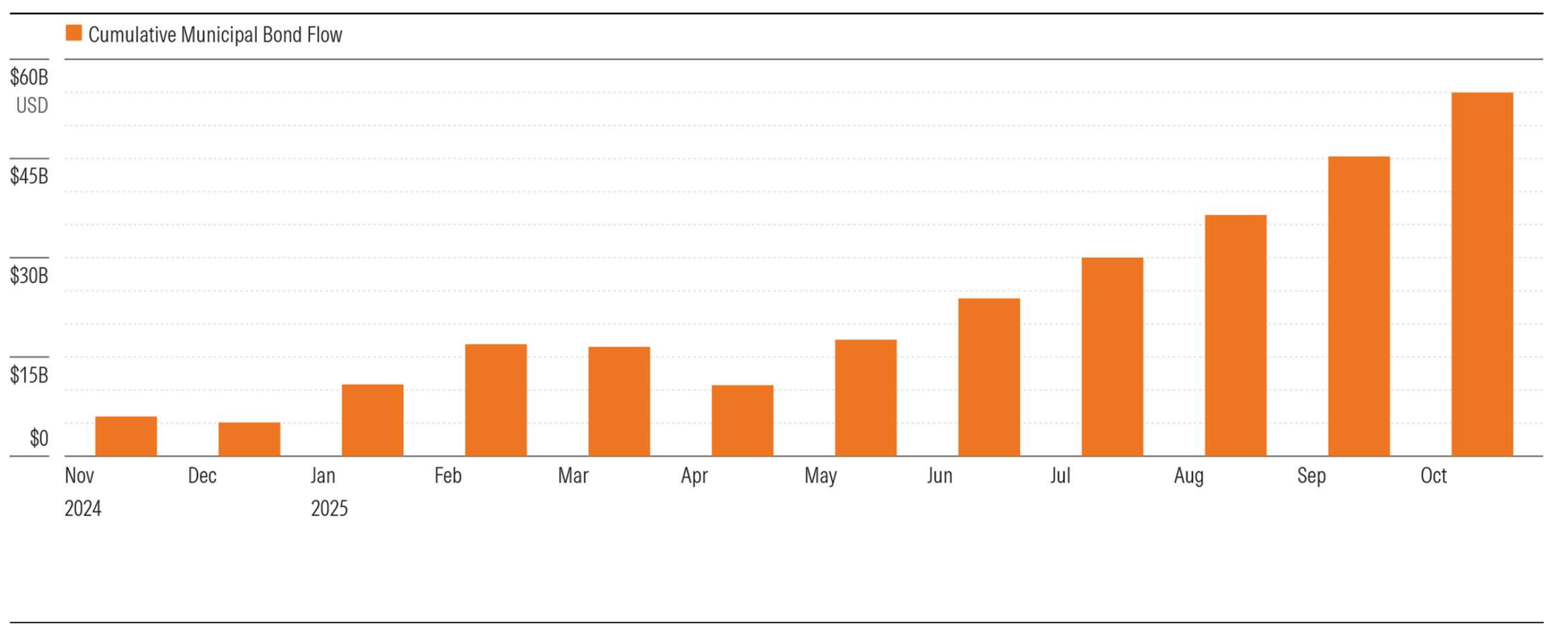5 min read
US Fund Flows: Mutual Fund Flows Lag as ETFs and Bond Funds Dominate in October

Key Takeaways
Long-term US mutual funds and exchange-traded funds gathered nearly $92 billion in October, topping September’s mark for the largest inflow of 2025.
Trends in equity fund flows persisted for the sixth consecutive month: International-equity funds added $10 billion and sector equity funds nearly $13 billion, while US equity funds shed nearly $20 billion. Passive US equity funds continued to collect new dollars, but not enough to offset outflows from active funds.
Exchange-traded funds collected a record $166 billion inflow in October, bringing 2025’s inflow to over $1 trillion. The three largest ETF fund families—iShares, Vanguard, and SPDR State Street—continue to be the biggest beneficiaries.
US investors poured nearly $92 billion into long-term funds in October, the largest inflow of 2025.
Consistent with the past several months, flows were concentrated in bond funds as investors searched for stability, while US equity funds shed assets for a sixth consecutive month as valuations pushed higher. Taxable- and municipal-bond funds both experienced their largest inflows since 2021, while technology equity funds experienced their largest inflow on record (and largest organic growth rate since February 2021) as artificial intelligence continued to fuel market gains
The charts below illustrate which direction the money is flowing for a variety of fund types. For a more complete analysis, download the full monthly report.
This data was sourced from Morningstar Direct. Not a user? Get a free trial of Direct.

Source: Morningstar Direct Asset Flows. Data as of Oct. 31, 2025.
Navigating Market Volatility Through Fund Flows Data
International Equity Bags Another Month of Inflows
As with US and sector-equity funds, the same themes were on repeat. International-equity funds gathered $10 billion in October, their sixth consecutive monthly inflow.
Like US equity, international fund flows have been dominated by passive constituents, whose nearly $18 billion inflow for the month covered for active’s $8 billion outflow. Another similarity has been outflows from growth-oriented funds; over the past year, international growth funds lost more than $14 billion.

Source: Morningstar Direct Asset Flows. Data as of Oct. 31, 2025. International growth funds include foreign large growth, global large-stock growth, and foreign small/mid growth.
ETF Giants Keep Growing
ETFs collected bumper inflows in October. Their $166 billion haul was the biggest month on record and brought total new money in 2025 to over $1 trillion.
About 60% of the monthly and year-to-date flows went to the three entrenched leaders in the space: iShares, with $3.87 trillion in total net assets; Vanguard, at $3.76 trillion; and SPDR State Street Investment Management, at $1.79 trillion.

Source: Morningstar Direct Asset Flows. Data as of Oct. 31, 2025.
As Tech Has Thrived, Health Has Dived
Sector-equity funds completed a half year of consecutive monthly inflows with a nearly $13 billion take in October, with technology funds claiming the lion’s share. In fact, over the past 12 months, tech funds have raised more than $26 billion, compared to $17 billion for the overall group. Meanwhile, tech and health funds have been two paths diverging in a wood, and health has been the road less traveled by investors.
Health funds have shed a cumulative $29 billion over the past 12 months as the sector has been hit by regulatory uncertainty, post-COVID hangover issues, and major selloffs of managed-care stocks.

Source: Morningstar Direct Asset Flows. Data as of Oct. 31, 2025.
More Muni Mania
For a second straight month, municipal-bond funds brought in large inflows, netting nearly $10 billion in October. The month’s 1.0% organic growth rate was the largest since 2021. Nearly $45 billion in new assets have flowed into these funds since April 2025, and the category nears $1 trillion in net assets.
Munibond funds across the credit and duration spectrum have continued to attract assets as tax-exempt yields have remained historically high and rates have trended downward.

Source: Morningstar Direct Asset Flows. Data as of Oct. 31, 2025.
More on Fund Flows from Morningstar
For more comprehensive analysis and commentary on US Fund Flows, download this month’s full report.
- Flows for the largest fund families
- Morningstar categories with the lowest and highest fund flows
- Government bond fund and money market flows
Morningstar’s asset fund flows history dates to 2008, with forecasting models for future growth rates. The Morningstar Direct application includes all fund flows data along with its performance reporting, presentation, and search capabilities. The Direct team also supports new users with onboarding, training materials, and 24-hour customer service.
Start a free trial of Morningstar Direct and evaluate fund flow data your way.
Note: The figures in this report were compiled on Sept. 30, 2025, and reflect only the funds that had reported net assets by that date. The figures in both the commentary and the extended tables are survivorship-bias-free. This report includes both mutual funds and exchange-traded funds but not funds of funds unless specifically stated. It does not include collective investment trusts or separate accounts. Important methodology note: Morningstar computes flows using the standard approach in the industry: Net flow is the estimated change in assets not explained by the performance of the fund. Our method assumes that flows occur uniformly over the course of the month. Adjustments for mergers are performed automatically. When liquidated funds are included, the fund's final assets are counted as outflows. Reinvested dividends are not counted as inflows. We use fund-level reinvestment rates to improve accuracy in this respect. We make ad hoc adjustments for unusual corporate actions such as reverse share splits, and we overwrite our estimates with actual flows if managers are willing to provide the data to us. When possible, Morningstar offsets outflows caused by transfers to other investment vehicles that share an identical mandate since they are not indicative of a change in investor interest.


